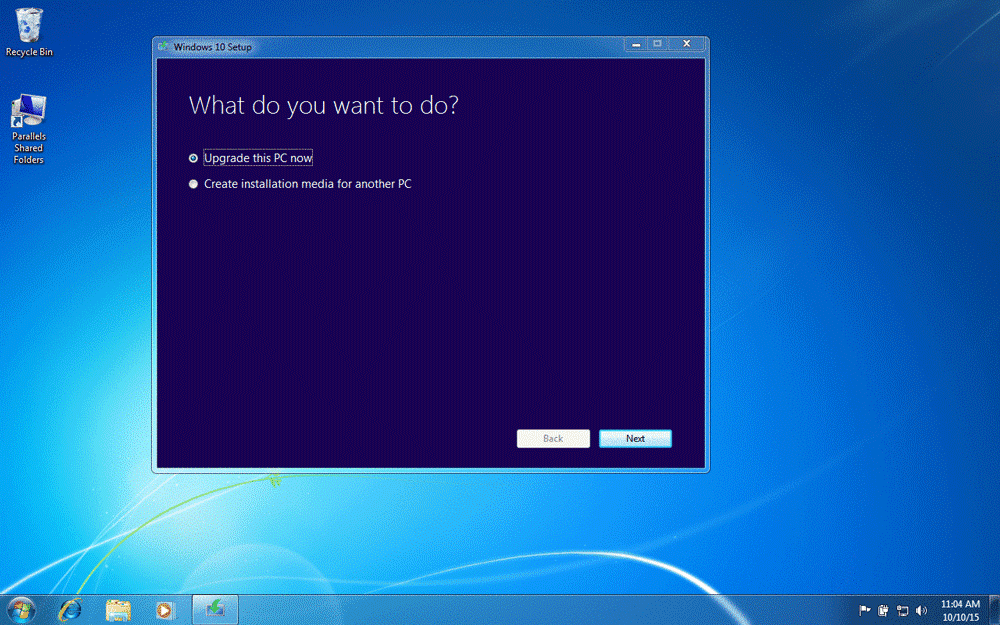
Recently, I thought of using Windows 10 but without having to switch my loyalty. I tried Apple’s Boot Camp software to. But I didn’t find the software much user-friendly as I had to partition the hard drive to make space for the new operating system. Hence, I thought of giving a chance to an efficient virtual machine like Parallels Desktop 13. Much to my surprise, running Windows 10 on Mac using Parallels Desktop 13 is a lot easier, and you will really like using it!
For those unfamiliar, a virtual machine is basically a virtual simulation of a real machine, which allows you to run a full-fledged operating system on your computer without needing to partition the hard drive. More significantly, you are able to run both the macOS and Windows on your Mac at one go. More after the jump. Sponsored Links How to Install Windows 10 on Mac Using Parallels Desktop 13 Want to have a go at Parallels Desktop? But before jumping ahead with the process, you need to ensure your Mac meets the requirements. As always, make sure to so that you remain on the safer side of the fence in case of any untoward incident. Your Mac Must.
Your Mac must have 850 MB of disk space on the boot volume. It must have an Intel Core 2 Duo, Core i3, Core i5, Core i7, Intel Core M or Xeon processor.
It must have minimum 4GB of memory; though 8GB would a preferable option. It needs to have an additional disk space. SSD drive would come very handy especially for boosting performance. Your Mac must be running OS X Yosemite 10.10.5 or later. Ensure your Mac is compatible with Windows 10. Sponsored Links. MacBook Pro (2012 and later).
MacBook Air (2012 and later). MacBook (2015 and later). iMac (2012 and later). iMac Pro (2017 and later). Mac mini (2012 and later). Mac mini Server (Late 2012). Mac Pro (Late 2013) More About the Software.

Parallels Desktop comes at $79.99 for a standard license. Its Pro Edition and Business Edition are priced at $99.99 per year. The company offers a free two-week trial. Hence, I would suggest you to first try out the free version of the software to ensure it ideally meets your needs before upgrading to the premium version.
Make sure you have a copy of Windows 10. If you don’t have Windows 10, you can get its copy from within Parallels Desktop.
Once you have checked all the requirements, head over with the process: Step #1. First off, you have to. After the program has been downloaded, double-click on the ParallelsDesktop.dmg file to open it. Sponsored Links Step #5. Now, you need to sign into your Parallels Desktop account.
You get the option to create one if you don’t have an account. Once you have signed up for Parallels Desktop account, Windows 10 will appear in a new window. Talking about the functionality, it seems very much like you are using a web browser with a virtual simulation of Windows 10 on top. Go ahead and give it a long spin!
And don’t forget to let us know your valuable feedback as well as whether or not you’d like to go for its premium version. That’s pretty much it, folks! Wrap up: Yes, macOS is widely considered to be more secure and efficient than Windows. But the gap between the two most popular operating systems has shrunk thanks to the arrival of several imposing features in Windows 10. What do you think of the competition between the two? You might want to read these posts as well:. Like this post?
And stay connected with us via, and to read more such stories.
Why Use Parallels Instead of Boot Camp or VirtualBox? RELATED: Sure, you could, but that means restarting your computer every time you need to use Windows. Parallels runs Windows within macOS, using what’s called a Virtual Machine. This allows you to quickly switch between the Mac and Windows desktops. You can even combine the two desktops, if you want, and run Windows software right on your Mac desktop from your Mac’s dock. Virtual machines are complicated, but Parallels makes it reasonably simple to set one up and use it.
There are other virtual machine options available to Mac users, including the open source, but Parallels is different in that it’s designed exclusively with Mac users in mind. Parallels costs more (since VirtualBox is free and Parallels is not), but there are hundreds of little design touches that help make running Windows within macOS as painless as possible, and that make setting everything up quick and easy. It’s well worth the cost. How Much Does Parallels Cost? Browsing the Parallels website, it can be a little tricky to find out what the product actually costs.
So here’s a quick breakdown:. Purchasing the latest home version of costs $80 as of this writing. This lets you run Parallels on a single Mac. Upgrading from one version of Parallels to another generally costs $50, and will probably be necessary every couple of years if you keep installing the latest versions of macOS. A $70 annual subscription gives you access to all updates “for free,” according to the Parallels website. RELATED: If you just want to try out Parallels and see if it works for you, you can: there’s a 14 day trial of the software, which you can access without providing a credit card number. There’s also, which is free on the Mac App Store and lets you create both Linux and macOS virtual machines.
Parallels Desktop Lite can only run Windows virtual machines if you pay for a subscription, however. One more note: purchasing Parallels does not give you a Windows license, or a Windows product key. If you have a Windows installation CD or USB key handy with a valid license you can use that, otherwise you will need to purchase Windows 10 from Microsoft to create a Windows 10 virtual machine.
RELATED: We’ll point out that —Microsoft basically gave up enforcing their license requirements with Windows 10, and you can (you’ll probably want it in the form of ). Legally speaking, however, you still need a product key to use Windows, even in a virtual machine. How to Install Windows in Parallels Got everything you need? The new virtual machine wizard, which launches the first time you open Parallels, makes the process simple.
Assuming you already have a Windows CD or ISO, click the “Install Windows or another OS from a DVD or image file” button. The ISO or DVD should be found automatically; otherwise, click the “Locate Manually” button. Then click “Continue.” You’ll be asked whether you want an Express installation, which automates the installation process so that you don’t need to enter the product key or click “Next” during the installation process. Choose this option if you want, otherwise plan on babysitting the installation a little bit. Next you’ll be asked what you plan on using this virtual machine for: work-related software or gaming.
If you select Games only, the virtual machine will be set to use a lot more resources, so only click that if you intend to do serious gaming in the virtual machine (which is probably not a great idea). Also make sure your Mac even has enough resources to dedicate—if you spread your computer’s resources too thin, your virtual machine will be very slow. You can change these settings later, but I recommend going with “Productivity” in almost all cases. Finally, you’ll be asked for a few details: what the machine should be named, where it should be located, and whether you want a shortcut to the machine on your desktop. You can also configure the settings before installation—don’t worry, you can tweak any of those later if you’d rather not dive in right now. Click “Continue.” The Windows installer will run. If you selected the Express installation, you won’t need to do anything: just watch as Windows installs.
If not, you’ll have to click “Next” a bunch of times and enter your product key, as is normal for installing Windows. The installation process can take a while, if mechanical hard drives or a DVD is involved. If everything is running off an SSD, however, you’ll be up and running in a few minutes. Eventually you’ll see the Windows desktop! We’re almost done. How to Seamlessly Integrate Your Virtual Machine Into macOS That’s all well and good, and you can start using Windows now—but if you really want to get the best of what Parallels has to offer, you have a few more steps ahead of you. At the top-right of your virtual machine you’ll see a caution sign.
This is letting you know that Parallels Tools needs to be installed. Installing this lets you move your mouse between macOS and Windows in one swift motion, and also makes it possible to access your Mac files from within Windows.
Install Nice Windows Under Parallels For Macbook Air

To get started, click that caution sign, then click “Install Parallels Tools.” Doing this will mount a virtual CD in the Windows virtual machine. You’ll be asked what you want to do by Windows; select “Install Parallels Tools.” The installer will take a few minutes, and eventually will require you to restart Windows. Do that and you’ll be up and running: your virtual machine will be integrated with macOS. Once Parallels Tools is installed, Windows integrates very cleanly with macOS. There are all kinds of examples of this:. Moving your mouse to your Windows virtual machine is seamless.
Anything you copy to your Windows clipboard can be pasted in Mac apps, and vice-versa. The Documents, Downloads, and Desktop folders in Windows are symbolically linked to the same folders in macOS. Change a file in one place and it changes in the other. If you have Dropbox or iCloud running in macOS, those folders are available in Windows Explorer. If you have OneDrive set up in Windows, that is available to you in macOS. Individual Windows programs are shown in your Mac’s dock. We could go on: the extent of the integrations is staggering.
If any of them bother you for any reason, you can change them by shutting the virtual machine down, then clicking the Settings button for it. Head to the “Sharing” tab to disable the folder sharing. And head to the “Applications” tab to stop Windows applications from showing up in your Mac dock. There are all kinds of other settings we could explore, but this article is only a starting point. Dive in and experiment. More Than Just Windows Parallels isn’t just for running Windows, either: you can use it to set up Linux, ChromeOS, and even macOS virtual machines.
We outlined, and the process is identical for the full version of Parallels Desktop, so check out that article if you’re interested. RELATED: If you intend to create a lot of virtual machines, you should also read about, because these machines will eat up a lot of hard drive space.